Archive:Warehousing and transport support services statistics - NACE Rev. 2
- Data from October 2015. Most recent data: Further Eurostat information, Main tables and Database."
This Statistics Explained article is outdated and has been archived - for recent articles on structural business statistics see here.
This article presents an overview of statistics for warehousing and transport support services in the European Union (EU), as covered by NACE Rev. 2 Division 52. It belongs to a set of statistical articles on 'Business economy by sector'.
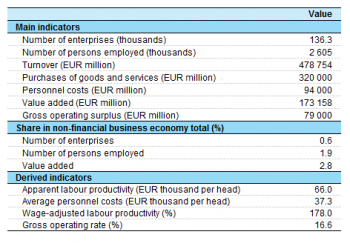
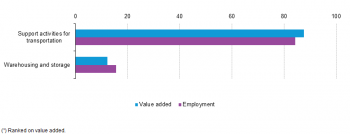
(% share of sectoral total) - Source: Eurostat (sbs_na_1a_se_r2)

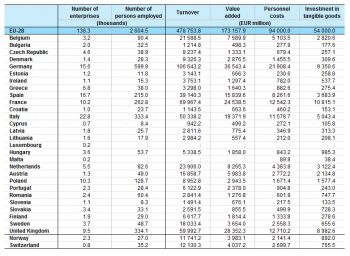



(% share of sectoral total) - Source: Eurostat (sbs_sc_1b_se_r2)
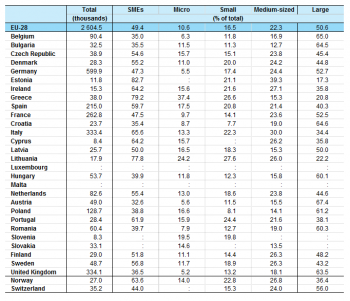
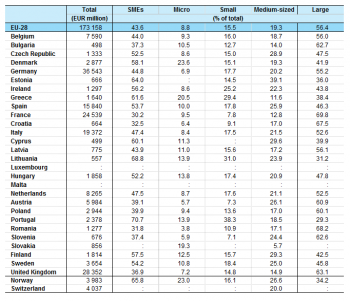
Structural profile
There were 136.3 thousand enterprises operating within the EU-28’s warehousing and transport support services (Division 52) sector in 2012. Together they employed 2.6 million persons, equivalent to 1.9 % of the non-financial business economy (Sections B to J and L to N and Division 95) workforce and one quarter (24.7 %) of those employed in transportation and storage services (Section H). They generated EUR 173.2 billion of value added, which was equivalent to 2.8 % of the non-financial business economy total and over one third (35.5 %) of the transportation and storage services total.
With its higher share of transportation and storage services value added (compared with its share of the workforce), the apparent labour productivity of the EU-28’s warehousing and transport support services sector in 2012 was EUR 66.0 thousand per person employed, considerably above the non-financial business economy average of EUR 46.2 thousand or the transportation and storage services average of EUR 46.0 thousand.
Average personnel costs within the EU-28’s warehousing and transport support services sector were, at EUR 37.3 thousand per employee in 2012, also above the non-financial business economy average (EUR 32.4 thousand) and the average for the whole of transportation and storage services (EUR 33.1 thousand); although the differences were relatively modest. As a result, the wage-adjusted labour productivity ratio, which shows the extent to which value added per person employed covers average personnel costs per employee, stood at 178.0 % for the EU-28’s warehousing and transport support services sector in 2012, compared with a non-financial business economy average of 142.7 % and a transportation and storage services average of 140.0 %.
The gross operating rate (which measures the relation between the gross operating surplus and turnover) is one measure of operating profitability; it stood at 16.6 % for the EU-28’s warehousing and transport support services sector in 2012, about 75 % higher than the non-financial business economy average of 9.4 % and also higher than the transportation and storage services average of 12.6 %.
Sectoral analysis
The warehousing and transport support services sector is divided into two NACE groups, the larger of these — using each of the main economic measures — was transportation support activities (Group 52.2). In terms of its share of enterprises, persons employed and value added, the EU-28’s transportation support activities subsector accounted for a share between 84 % and 89 % of the sectoral total. There were 120.4 thousand enterprises within the EU-28’s transportation support activities subsector, which together employed 2.2 million persons, and generated added value of EUR 151.8 billion in 2012. The warehousing and storage subsector (Group 52.1) was much smaller and was made-up of 15.9 thousand enterprises with 408 thousand persons employed.
EU-28 apparent labour productivity in the transportation support activities subsector was EUR 69.0 thousand per person employed in 2012, which was some EUR 17.0 thousand higher than the corresponding ratio for warehousing and storage. Equally, average personnel costs were higher for the transportation support activities subsector (EUR 38.5 thousand per employee) than for warehousing and storage, where the figure for 2012 (EUR 31.0 thousand per employee) was slightly below the non-financial business economy average. The wage-adjusted labour productivity ratios and gross operating rates of both subsectors were relatively high, and these were systematically above the non-financial business economy averages as well as the transportation and storage services averages.
Country analysis
Germany generated EUR 36.5 billion of value added in the warehousing and transport support services sector in 2012, equivalent to 21.1 % of the EU-28 total. There were also relatively high shares of the EU-28 total for the United Kingdom (16.4 %) and France (14.2 %), while Italy (11.2 %) was the only other country to record a double-digit share of EU-28 value added. Germany had a slightly higher share of the warehousing and transport support services sector’s workforce, 23.0 % of the EU-28 total in 2012. Estonia’s 0.4 % share of EU-28 value added in this sector was its fourth highest share in 2012 among all of the non-financial business economy NACE divisions, while Latvia’s 0.4 % share was its third highest. Unsurprisingly, these two Baltic Member States had the highest degree of specialisation for warehousing and transport support services: Latvia and Estonia generated 8.4 % and 7.1 % respectively of their non-financial business economy value added from transportation support activities in 2012; Cyprus and Lithuania were also highly specialised in this sector in value added terms.
Most of the EU Member States reported relatively high wage-adjusted labour productivity ratios for warehousing and transport support services in 2012, a majority of Member States had a ratio for this sector that was above their national non-financial business economy average. The highest wage-adjusted labour productivity ratios were recorded in Slovenia (287.8 %) and Estonia (279.4 %), while other seven EU Member States had also ratios above 200.0 %; the Slovenian ratio was the highest wage-adjusted labour productivity ratio recorded in Slovenia in 2012 among all of the non-financial business economy NACE divisions.
Size class analysis
The role of small and medium-sized enterprises (SMEs, employing fewer than 250 persons) within the EU-28’s warehousing and transport support services sector in 2012 was somewhat less than their average role within the non-financial business economy. SMEs employed 49.4 % of the warehousing and transport support services workforce and generated 43.6 % of sectoral value added, compared with their 67.0 % and 57.5 % shares of non-financial business economy employment and value added. As was the case in most sectors, large enterprises (employing 250 or more persons) recorded the highest apparent labour productivity ratios in the warehousing and transport support services sector, averaging EUR 74.1 thousand per person employed. Somewhat unusual, but not unique, was the higher apparent labour productivity for small enterprises (employing 10 to 49 persons) than for medium-sized enterprises (employing 50 to 249 persons) — see Table 5.
Large enterprises provided half of the warehousing and transport support services sector’s workforce or more in eleven EU Member States in 2012, with this share exceeding 60.0 % in eighth of these and peaking at 67.4 % in Austria. Only in Lithuania (22.2 %), Greece (20.8 %) and Estonia (17.3 %) did large enterprises employ less than one third of the workforce. In value added terms, the importance of large enterprises was generally greater, although this was not the case in nine of the Member States for which data are available, most notably in Hungary, Belgium, Portugal, Austria and Finland.
Data sources and availability
The analysis presented in this article is based on the main dataset for structural business statistics (SBS) and size class data, all of which are published annually.
The main series provides information for each EU Member State as well as a number of non-member countries at a detailed level according to the activity classification NACE. Data are available for a wide range of variables.
In structural business statistics, size classes are generally defined by the number of persons employed. A limited set of the standard structural business statistics variables (for example, the number of enterprises, turnover, persons employed and value added) are analysed by size class, mostly down to the three-digit (group) level of NACE. The main size classes used in this article for presenting the results are:
- small and medium-sized enterprises (SMEs): with 1 to 249 persons employed, further divided into;
- micro enterprises: with less than 10 persons employed;
- small enterprises: with 10 to 49 persons employed;
- medium-sized enterprises: with 50 to 249 persons employed;
- large enterprises: with 250 or more persons employed.
Context
This article presents an overview of statistics for the warehousing and transport support services sector in the EU, as covered by NACE Rev. 2 Division 52.
The warehousing and storage activity includes the operation of storage and warehouse facilities for all kinds of goods, for example, in grain silos, general or refrigerated warehouses, storage tanks and so on, as well as in foreign trade zones.
Support activities for transportation includes activities supporting the transport of passengers or freight, such as the operation of parts of the transport infrastructure or activities related to handling freight immediately before or after transport or between transport segments. The operation and maintenance of all transport facilities is also included. Examples of transport infrastructure include: airports, harbours, tunnels, bridges, and so on. Also included in incidental service activities are: towing and road side assistance and liquefaction of gas for transportation purposes; navigation, pilotage and berthing activities, lighterage, salvage activities and lighthouse activities; ground service activities on airfields and fire fighting and fire-prevention services at airports. Other transport support activities include, for example, freight forwarding and brokerage, as well as activities of customs agents.
This NACE division is composed of two groups:
- warehousing and storage (Group 52.1);
- support activities for transportation (Group 52.2).
Self-storage facilities and the rental of vacant space (part of Division 68, covered within real estate activities), as well as the activities of travel agencies and tour operators and related activities (Division 79, travel agency, tour operator and other reservation service and related activities) are excluded from the statistics presented in this article.
See also
- Other analyses of the business economy by NACE Rev. 2 sector
- Structural business statistics introduced
- Transportation and storage
Further Eurostat information
Publications
- European business - facts and figures (online publication)
- Key figures on European Business – with a special feature section on SMEs – 2011 edition
Main tables
Database
- SBS – services (sbs_serv)
- Annual detailed enterprise statistics - services (sbs_na_serv)
- Annual detailed enterprise statistics for services (NACE Rev. 2 H-N and S95) (sbs_na_1a_se_r2)
- SMEs - Annual enterprise statistics by size class - services (sbs_sc_sc)
- Services by employment size class (NACE Rev. 2 H-N and S95) (sbs_sc_1b_se_r2)
- Annual detailed enterprise statistics - services (sbs_na_serv)
- SBS - regional data - all activities (sbs_r)
- SBS data by NUTS 2 regions and NACE Rev. 2 (from 2008 onwards) (sbs_r_nuts06_r2)
Dedicated section
Source data for tables and figures (MS Excel)
Other information
- Decision 1578/2007/EC of 11 December 2007 on the Community Statistical Programme 2008 to 2012
- Regulation (EC) No 295/2008 of 11 March 2008 concerning structural business statistics